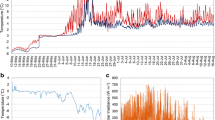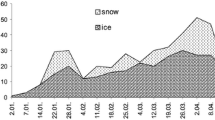Summary
The filamentous chlorophyte Spirogyra forms a mat covering extensive areas of Spirogyra Lake, a small, shallow, Antarctic lake. It has an annual growth pattern, with a maximum standing crop of 400 μg chlorophyll-α m-2 during the ice-free summer period. Nutrient concentrations were low and there was evidence for P-limitation. The attainment of such a high standing crop was probably dependent on the lake's high specific dilution rate. Radiation flux was very low under winter ice cover and Spirogyra died back almost completely. The lake water became hypoxic and inorganic nutrients accumulated in both the water column and overwintering algal filaments. Spore formation was not observed, but changes in the composition of filaments indicated that polysaccharides, which had accumulated in summer, were depleted over the long, ice-covered winter period.
Similar content being viewed by others

References
Amenta JS (1964) A rapid chemical method for quantification of lipids separated by thin layer chromatography. J Lipid Res 5:270–273
Auer MA, Graham JM, Graham LE, Kranzfelder JA (1983) Factors regulating the spatial and temporal distributions of Cladophora and Ulothrix in the Laurentian Great Lakes. In: Wetzel RG (ed) Periphyton of freshwater ecosystems. Junk, The Hague, pp 135–145
Bartlett GR (1959) Phosphorus assay in column chromatography. J Biochem 234:466–468
Cattaneo A (1987) Periphyton in lakes of different trophy. Can J Fish Aquat Sci 44:296–303
Chaney AL, Marbach EP (1962) Modified reagents for the determination of urea and ammonia. Clin Chem 8:71–76
Church M (1975) Electrochemical and fluorometric tracer techniques for stream flow measurements. Tech Bull Br Geomorph Res Group No 12
Collyer DM, Fogg GE (1955) Studies on fat accumulation in algae. J Exp Bot 6:256–275
Cook JR (1963) Adaptions in growth and division in Euglena effected by energy supply. J Protozool 10:436–444
Dawson FH (1981) An inexpensive photosynthetic irradiance sensor for ecological field studies. Hydrobiologia 77:71–76
Dubois M, Gilles KA, Hamilton JK, Rebers PA, Smith F (1956) Colorimetric method for determination of sugars and related substances. Anal Chem 28:350–354
Eisenreich SJ, Bannerman RT, Armstrong DE (1975) A simplified phosphorus analysis technique. Environ Lett 9:43–53
Ellis-Evans JC (1985) Decomposition processes in maritime Antarctic lakes. In: Siegfried W, Condy PR, Laws RM (eds) Antarctic nutrient cycles and food webs. Springer, Berlin, pp 253–260
Erben K (1962) Sporulation. In: Lewin RA (ed) Physiology and biochemistry of algae. Academic Press, London New York, pp 701–710
Forsberg C, Ryding SO, Claesson A, Forsberg A (1978) Water chemical analysis and/or algal assay? Sewage effluent and polluted lake water studies. Mitt Int Verein Limnol 21:352–363
Harris GP (1978) Photosynthesis, productivity and growth: The physiological ecology of phytoplankton. Arch Hydrobiol Beih 10:171 pp
Hawes I (1983) Nutrients and their effects on phytoplankton populations in lakes on Signy Island, Antarctica. Polar Biol 2:115–126
Hawes I (1985) Light climate and phytoplankton photosynthesis in maritime Antarctic lakes. Hydrobiologia 123:69–79
Heywood RB (1977) Antarctic freshwater ecosystems: review and synthesis. In: Llano GA (ed) Adaptations within Antarctic ecosystems. Smithsonian Institution, Washington DC, pp 829–837
Heywood RB, Dartnall HJG, Priddle J (1980) Characteristics and classification of the lakes of Signy Island, South Orkney Islands, Antarctica. Freshwater Biol 10:47–59
Kalff J, Welch HE (1974) Phytoplankton production in Char Lake, a natural polar lake, and in Meretta Lake, a polluted polar lake, Cornwallis Island, Northwest Territories. J Fish Res Board Can 31:621–636
Larsen DP, Schults DW, Malueg KW (1981) Summer internal phosphorus supplies in Shagawa Lake, Minnesota. Limnol Oceanogr 26:740–753
Lewis MR, Kemp WM, Cunningham JJ, Stevenson JC (1982) A rapid technique for the preparation of aquatic macrophyte samples for measuring 14-C incorporation. Aquat Bot 13:203–207
Light JJ, Ellis-Evans JC, Priddle J (1981) Phytoplankton ecology in an Antarctic lake. Freshwater Biol 11:11–26
Marker AFH (1980) A note on the extraction of chlorophyll from benthic algae using methanol. Arch Hydrobiol Beih 14:88–90
Marker AFH, Nusch EA, Rai H, Riemann B (1980) The measurement of photosynthetic pigments in freshwaters and a standardisation of methods: conclusions and recommendations. Arch Hydrobiol Beih 14:91–106
McCracken MD, Gustafson TD, Adams MS (1974) Productivity of Oedogonium in Lake Wingra, Wisconsin. Am Midl Nat 92:247–254
Morgan K, Kalff J (1975) The winter survival of an algal flagellate Cryptomonas erosa (Skuja). Verh Int Ver Limnol 19:2734–2740
Morris I (1981) Photosynthesis products, physiological state and phytoplankton growth. In: Platt TE (ed) physiological bases of phytoplankton ecology. Can Bull Fish Aquat Sci 210:83–102
Morris I, Glover HE, Yentsch CS (1974) Products of photosynthesis by marine phytoplankton: the effect of environmental factors on the relative rates of protein synthesis. Mar Biol 27:1–9
Morries P (1971) A note on the ultra-violet spectrophotometric method for the determination of nitrate in water. Water Treat Exam 20:132–137
Myers J (1949) The pattern of photosynthesis in Chlorella. In: Franck J and Loomis WE (eds) Photosynthesis in plants. Am Soc Plant Physiol, Iowa State College Press, pp 349–364
Mykelstad S (1974) Production of carbohydrates by marine planktonic organisms. I. Comparison of nine different species in culture. J Exp Mar Biol Ecol 15:261–274
O'Neal SW, Lembi CA, Spencer DF (1985) Productivity of the filamentous alga Pithophora oedogonia (Chlorophyta) in Surrey Lake, Indiana. J Phycol 21:162–176
Palmisano AC, Sullivan CW (1982) Physiology of sea ice diatoms. II. Dark survival of three polar diatoms. Can J Microbiol 29:157–160
Priddle J (1980a) The production ecology of benthic plants in some Antarctic lakes. I. In situ production studies. J Ecol 68:141–153
Priddle J (1980b) The production ecology of benthic plants in some Antarctic lakes. II. Laboratory physiology studies. J Ecol 68:155–166
Priddle J, Hawes I, Ellis-Evans JC (1986) Antarctic aquatic ecosystems as habitats for phytoplankton. Biol Rev 61:199–238
Reynolds CS (1984) The ecology of freshwater phytoplankton. Cambridge University Press, Cambridge, 384 pp
Rhee G-Y (1978) Effects of N:P atomic ratios and nitrate limitation on algal growth, cell composition and nitrate uptake. Limnol Oceanogr 23:10–25
Rhee G-Y, Gotham IJ (1980) Optimum N:P ratios and coexistence of planktonic algae. J Phycol 16:486–489
Richardson K, Beardall J, Raven JA (1983) Adaptations of unicellular algae to irradiance: an analysis of strategies. New Phytol 93:157–191
Senft WH (1978) Dependence of light-saturated rates of algal photosynthesis on intracellular concentrations of phosphorus. Limnol Oceanogr 23:709–718
Smith AE, Morris I (1980) Pathways of carbon assimilation in phytoplankton from the Antarctic Ocean. Limnol Oceanogr 25:865–872
Smith RIL (1984) Terrestrial plant ecology of the sub-Antarctic and Antarctic. In: Laws RM (ed) Antarctic ecology. Academic Press, London, pp 61–162
Steeman Nielsen E (1962) On the maximum quantity of plankton chlorophyll per surface unit of a lake or sea. Int Rev Hydrobiol 47:335–338
Talling JF (1973) The application of some electrochemical methods to the measurement of photosynthesis and respiration in freshwater. Freshwater Biol 3:333–362
Welch HE (1974) Metabolic rates of arctic Lakes. Limnol Oceanogr 19:65–73
Welch HE, Bergmann MA (1985) Winter respiration of lakes at Saqvaqjuac, N.W.T. Can J Fish Aquat Sci 42:521–528
Author information
Authors and Affiliations
Rights and permissions
About this article
Cite this article
Hawes, I. The seasonal dynamics of Spirogyra in a shallow, maritime Antarctic lake. Polar Biol 8, 429–437 (1988). https://doi.org/10.1007/BF00264719
Received:
Accepted:
Issue Date:
DOI: https://doi.org/10.1007/BF00264719



